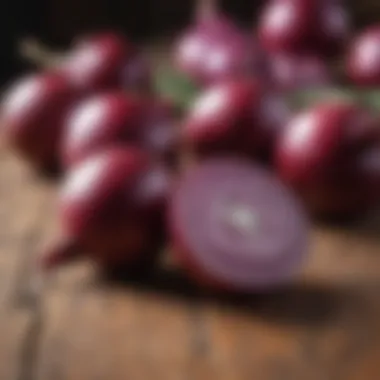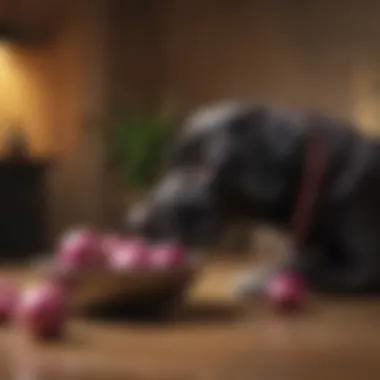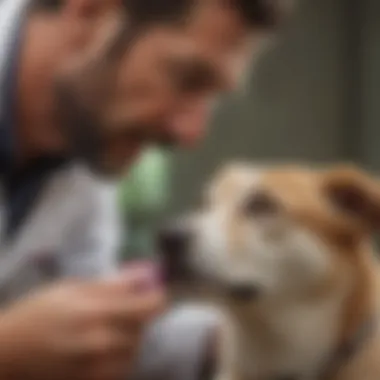Can Dogs Eat Red Onions? Understanding the Risks


Intro
Red onions are a staple in many kitchens around the world, prized for their flavor and versatility. However, when it comes to canine consumption, the question of whether dogs can safely eat red onions emerges. This article delves into the potential health risks associated with feeding dogs this common vegetable. Understanding onion toxicity is crucial for dog owners, as it can lead to serious health consequences for pets. By exploring the physiological effects of onions on dogs, this guide aims to provide comprehensive information to assist responsible pet ownership.
Onion Toxicity and Its Effects on Dogs
Onions, particularly red onions, contain compounds that are toxic to dogs. These compounds, primarily thiosulfate, can cause oxidative damage to red blood cells, leading to a condition known as hemolytic anemia. Here are some key points about onion toxicity in dogs:
- Symptoms: Ingesting onions can cause a range of symptoms. These may include vomiting, diarrhea, stomach pain, fatigue, and pale gums. Severe cases can lead to a noticeable increase in heart rate and elevated respiratory rates.
- Dosage: Even small amounts of onions can be harmful to dogs, especially over time. A common threshold for toxicity is approximately 15-30 grams of onion per kilogram of body weight.
- Types of Onions: All varieties of onions contain thiosulfate to some extent. However, red onions tend to have higher concentrations, making them particularly dangerous.
"The toxicity level can vary based on the individual dog's health status, size, and frequency of consumption."
Related Foods to Avoid
In addition to onions, several other food items should also be avoided. These include:
- Garlic: Similar to onions, garlic can lead to the same toxic effects.
- Shallots: These are part of the onion family and carry the same risks.
- Leeks: Another member of the allium family, leeks are also harmful to dogs.
Emergency Responses to Ingestion
If a dog accidentally consumes red onions, it is vital that owners act quickly. Here are steps to follow:
- Contact a Veterinarian: Immediate consultation with a veterinarian is crucial. The vet may ask about the amount consumed and the time of ingestion.
- Inducing Vomiting: In some situations, the vet might recommend inducing vomiting, especially if the ingestion was recent.
- Monitor Symptoms: Keep a close watch for any signs of distress or illness. Reporting any symptoms to the vet can aid in diagnosis and treatment.
Understanding Onion Toxicity in Dogs
Understanding onion toxicity in dogs is crucial for pet owners. Many do not realize that common kitchen ingredients can pose significant health risks to their pets. Onions, including red onions, contain compounds that can lead to serious health issues when ingested by dogs. This section discusses the toxic effects of onions and why this knowledge is essential for safeguarding canine health.
Chemical Composition of Onions
Onions are part of the Allium family, which also includes garlic, shallots, and leeks. The primary toxic component found in onions is thiosulfate. This compound can lead to oxidative damage in red blood cells in dogs. Additionally, onions have other components - such as various minerals and vitamins - which, while beneficial to humans, can be harmful to dogs. When dogs consume onions, even in small amounts, the subsequent breakdown of thiosulfate can disrupt their red blood cells, potentially leading to hemolytic anemia.
Impact of Thiosulfate on Canines
The impact of thiosulfate on canines is severe. Once thiosulfate enters a dog's system, it can cause oxidative damage to red blood cells. This results in a reduction in the red blood cell count over time. Dogs may not show immediate symptoms, which can lead to a delayed recognition of the issue. Symptoms of onion toxicity include lethargy, weakness, and pale gums. In extreme cases, ingestion can lead to organ damage due to the increased workload on the body trying to filter toxins.
It is essential for dog owners to be vigilant about what they feed their pets. Education about the risk of onion consumption can prevent accidental poisoning and ensure that dogs remain healthy and safe.
Red Onions vs. Other Onion Types
Understanding the differences among varieties of onions is essential for dog owners. Red onions are commonly used in culinary practices; however, they possess specific properties that can significantly affect dog health. This section will focus on the nutritional content of red onions and how it compares to other onion types. Factors such as toxicity levels will also be discussed, shedding light on how these onions impact dogs when consumed.
Nutritional Content of Red Onions
Red onions are known for their vibrant color and unique flavor. They contain several nutrients beneficial to humans, such as vitamins C and B6, potassium, and fiber. However, the nutritional content that is positive for human consumption may not translate similarly for dogs. These nutrients, while advantageous for people, do not contribute positively and could be harmful to canines. Dogs metabolize these nutrients differently, which can lead to adverse effects.
Comparative Toxicity Levels
White Onions
White onions are commonly used in various dishes. They contain higher levels of thiosulfate, which is toxic to dogs. The amount of thiosulfate present in white onions is significantly higher than that in red onions. This makes white onions a particularly dangerous choice for pet owners. Given that they can lead to hemolytic anemia even in small quantities, proper awareness of their toxicity is crucial.


Yellow Onions
Yellow onions are another common variety, and they also retain high levels of thiosulfate. They are similar in properties to white onions but may present a slightly lower toxicity risk. The impact on dogs is still significant and comparable to that of white onions. It’s essential to keep yellow onions away from dogs to prevent health complications, as they share common toxic traits.
Shallots
Shallots are milder and sweeter compared to their onions counterparts. However, they still contain thiosulfate, posing a risk of toxicity to dogs. Although they may be less harmful than white or yellow onions, it is prudent to avoid allowing dogs to consume them. The health risks associated with shallots are enough to classify them as unsafe for canine diets.
It is important to note that all onions, regardless of type, can pose a danger to dogs. Awareness and caution are vital for pet owners.
In summary, red onions, alongside other types, can lead to harmful reactions in dogs. Understanding the differences among these varieties can assist dog owners in making informed dietary choices for their pets.
Physiological Effects on Dogs
Understanding the physiological effects that onions, specifically red onions, have on dogs is crucial. This knowledge is essential for dog owners to ensure the well-being of their pets. Onion toxicity can lead to a variety of health issues, which can be acute or chronic in nature. Recognizing the signs of toxicity can help in seeking timely veterinary intervention, ultimately safeguarding a dog's health.
Symptoms of Onion Toxicity
Symptoms of onion toxicity can manifest in various ways. Some of the most common signs include vomiting, diarrhea, lethargy, and abdominal pain. These symptoms can significantly impact a dog's daily activities and wellbeing.
Vomiting
Vomiting is often one of the first symptoms seen in dogs that have ingested red onions. It occurs as the body's way of expelling the harmful substances. The key characteristic of vomiting in this context is its role as a protective measure. While it can be distressing for the dog, it helps to remove toxic components before they can enter the system. However, if it persists, it can lead to dehydration, which complicates the initial issue.
Diarrhea
Diarrhea is another common response to onion toxicity. It typically follows vomiting and may indicate that the digestive system is struggling to process the toxins. The key characteristic of diarrhea is the frequency and liquid consistency of the stool, which can lead to further dehydration. This symptom signals that immediate attention may be needed to prevent more severe complications.
Lethargy
Lethargy in dogs can signify serious underlying issues following onion ingestion. It refers to a noticeable lack of energy or enthusiasm, where the dog may appear weak or unresponsive. This is a key characteristic as it suggests that the body is attempting to cope with the toxic effects by conserving energy. Lethargy itself can prompt concern as it usually means that the dog is not feeling well and requires assessment by a veterinarian.
Abdominal Pain
Abdominal pain can indicate gastrointestinal distress resulting from onion toxins. Dogs may exhibit signs such as whining, a hunched position, or reluctance to engage in normal activities. This symptom is characterized by discomfort and can lead to more serious conditions if left untreated. Early recognition of abdominal pain can prevent further complications and necessitate medical intervention.
Long-Term Health Implications
The long-term health implications of onion toxicity must not be overlooked. If a dog suffers from onion ingestion, the risks are not merely short-lived. Two significant long-term health issues arise: anemia and organ damage.
Anemia
Anemia is a critical condition that arises when red blood cells are destroyed in numbers exceeding what the body can replenish. The key characteristic of anemia is fatigue and pale gums in affected dogs. This condition can lead to diminished oxygen transport in the body, which is detrimental. Understanding the connection between onion consumption and potential anemia highlights the importance of preventive measures.
Organ Damage
Organs, particularly the liver and kidneys, can sustain damage from prolonged exposure to onion toxins. The key characteristic of organ damage is the reduction in the organ's ability to function properly. This long-term effect can lead to chronic health issues requiring lifelong management. Awareness of the danger posed by red onions can help to mitigate the risk of such serious conditions.
In summary, understanding the physiological effects of red onions on dogs is critical for protecting their health.
The knowledge of symptoms and the long-term implications fosters educated decisions among dog owners, reinforcing responsible pet ownership.
Safe Alternatives to Include in Dog Diets


Understanding safe alternatives in a dog's diet is very important for dog owners. Replacing harmful foods with nutritious options can significantly improve a dog's health. Since red onions pose health risks due to toxicity, identifying safe alternatives helps ensure that canine diets remain healthy and palatable.
Safe Vegetables for Dogs
Carrots
Carrots are a good addition to a dog’s diet. They are low in calories and high in fiber, which aids digestion. This vegetable also provides essential vitamins like Vitamin A, which is good for vision and skin health.
One unique feature of carrots is their crunchiness. This texture can help clean a dog’s teeth during chewing. Moreover, many dogs enjoy the taste of fresh carrots, making them an appealing snack. However, it is important to cut them into manageable pieces to avoid choking hazards, especially for smaller dogs.
Sweet Potatoes
Sweet potatoes are another excellent choice for dogs. They are packed with nutrients, like Vitamin B6 and Vitamin C, which support the immune system. Their natural sweetness can attract dogs, encouraging them to eat healthy foods.
The unique feature of sweet potatoes is their high fiber content, which helps with digestion. Although they can be prepared in many ways, it’s crucial to cook them thoroughly before feeding them to dogs. Raw sweet potatoes can be hard to digest. Overall, sweet potatoes are a beneficial dietary substitute for red onions.
Healthy Fruits for Dogs
Berries
Berries, such as blueberries and strawberries, are a fantastic fruit option for dogs. They are low in calories and high in antioxidants. These compounds assist in fighting inflammation and provide health benefits.
The key characteristic of berries is their natural sweetness, which most dogs find enjoyable. Their small size makes them easy for dogs to consume. However, moderation is essential, as too much fruit can lead to digestive upset. Overall, berries are a healthy addition to a dog's diet, providing both taste and nutrition.
Apples
Apples are another safe and nutritious fruit for dogs. They offer Vitamins A and C, supporting overall health. Plus, the fiber in apples can aid digestion, making them a good treat.
One unique feature of apples is the crunchy texture, which can provide a satisfying chew for dogs. However, it’s vital to remove the seeds and core before offering apples to dogs, as the seeds contain cyanide, which is harmful in large amounts. This precaution ensures that apples can be a safe, healthy snack for dogs.
Emergency Response Guidelines
Understanding the proper emergency response is crucial when it comes to canine exposure to red onions. Owners must be informed about the appropriate actions to take as soon as they suspect that their dog has ingested onions. Having a clear plan helps minimize health risks and prevent long-term damage to the animal. By knowing the right steps to follow, dog owners can act swiftly, making a difference in the outcomes of toxicity.
Recognizing Toxicity Symptoms
Recognizing the early signs of onion toxicity in dogs is essential. Symptoms can vary in severity and may not be immediately apparent. Common indicators include:
- Vomiting: This can occur shortly after ingestion.
- Diarrhea: Dogs may have loose stools or diarrhea.
- Lethargy: Decreased energy levels can signal distress.
- Abdominal Pain: Dogs may show discomfort and excessive drooling.
It's vital for owners to monitor their pets closely. If any of these symptoms are observed, immediate action is recommended.
When to Contact a Veterinarian
Contacting a veterinarian is imperative if any symptoms are observed. The sooner a medical professional evaluates the situation, the better. Ingesting a small amount of onion may not be concerning, but proactive engagement with veterinary services can prevent complications. Owners should provide the veterinarian with information such as:
- The type and amount of onion ingested.
- Time elapsed since ingestion.
- Any observable symptoms.
This information helps veterinarians determine the best course of action for the dog.
Treatment Options for Onion Toxicity
Dogs that have consumed red onions may require treatment options to mitigate the effects of toxicity. Two common treatment methods are:


Induced Vomiting
Induced vomiting is a common treatment for onion toxicity. This procedure allows the dog to expel the harmful substance before it can lead to more severe issues. The key characteristic of induced vomiting is its immediacy, as it is most effective shortly after ingestion. Benefits include:
- Quick Removal: Effective in clearing the toxins from the stomach.
- Lower Risk of Complications: Reduces chances of further absorption into the bloodstream.
However, it is not suitable for all cases. If the dog shows severe symptoms, inducing vomiting might not be advisable. Always consult a veterinarian before proceeding.
Activated Charcoal
Activated charcoal is another effective treatment option. This substance absorbs toxins and prevents them from entering the bloodstream. The main advantage lies in its ability to bind toxins, significantly decreasing their absorption. Some important features of activated charcoal include:
- Wide Usage: Commonly used in various poisonings.
- Generally Safe: Considered low-risk when administered properly.
Nevertheless, it has limitations. For example, it should not be given if the dog is unconscious or having seizures. Discussing with a veterinarian is essential before administering activated charcoal to ensure it is necessary and safe.
By following these emergency response guidelines, dog owners can significantly enhance their pet's chances of recovery following onion exposure. Being educated on recognizing symptoms and knowing when to seek veterinary help can lead to timely interventions.
Preventing Accidental Ingestion
Preventing accidental ingestion of red onions is crucial for safeguarding the health of dogs. These ingredients may be common in human food preparation but carry significant risks for canines. By taking the necessary precautions, dog owners can help ensure their pets avoid the dangerous effects associated with onion consumption.
One key aspect of prevention is understanding where onions are typically stored and how they might be accessed by pets. Many households keep onions in pantry or kitchen cabinets, which may not be barriers for a curious dog. Ensuring these ingredients are kept in secured locations is essential.
Additionally, educating everyone in the household about the dangers of onions is vital. This includes explaining the potential hazards and making sure good practices are followed, especially in households with children who may not grasp the risks.
Safe Food Storage Practices
Safe food storage practices play a significant role in minimizing risks. Here are some effective strategies:
- Secure Locations: Always store onions in cabinets or shelves that are out of reach from pets. This includes high shelves or closed containers that can’t easily be opened by your dog.
- Proper Sealing: Use airtight containers for onion storage. This prevents the smell from wafting and enticing dogs to investigate.
- Use of Labels: Label containers clearly to ensure everyone in the household easily identifies harmful foods. Also, mark them as "keep out of reach of pets" for additional caution.
Establishing a habit of checking the kitchen before meal preparations can further help in accident prevention.
Educating Household Members
Educating all household members about the risks of onion ingestion is essential in preventing accidents. Here are important points to consider:
- Communication: Make sure everyone, including children, understands that some foods can harm pets. Use simple language to explain why red onions are dangerous.
- Regular Reminders: Give reminders to check common areas where onions are kept. This reinforces cautious behavior every time food is being prepared.
- Discuss Alternatives: Share knowledge about safe dog foods and treats that can be given instead of risky human food. This not only protects pets but also promotes healthier feeding habits.
Educating household members reduces the risk of unintentional exposure to harmful foods, fostering a safer environment for pets.
Endings and Best Practices
Understanding the implications of dogs consuming red onions is vital for pet owners. The insights presented throughout this article emphasize not just the dangers of onion toxicity but also underline the holistic approach required in maintaining canine health. Recognizing the nutritional needs of dogs and the potential threats embedded within common human foods helps in fostering responsible pet ownership.
Maintaining a Balanced Diet
Dogs require a balanced diet tailored to their specific needs. This means more than just feeding them standard kibble. Pet owners should consider including a variety of safe vegetables, fruits, and proteins to ensure that their pets receive all essential nutrients. Carrots, sweet potatoes, and berries are excellent options and can contribute to overall health.
Moreover, monitoring dietary intake is equally important. Sudden changes in a dog’s diet can lead to gastrointestinal issues. Always introduce new foods gradually and observe for any adverse reactions. This careful approach minimizes risks involved with potential toxins, such as those found in red onions. To promote optimal health, keeping track of what ingredients are beneficial or harmful to dogs is necessary.
Responsible Pet Ownership
Pet ownership comes with numerous responsibilities, particularly regarding diet and health. Educating oneself about the unique dietary requirements of dogs can prevent scenarios where a pet might consume harmful substances, including red onions. It is advisable to have a thorough understanding of which foods are safe and which ones pose health risks.
Additionally, communication within the household about food safety is essential. All family members, including children, should be made aware of the dangers related to specific foods. Understanding and implementing proper food storage practices can further reduce the risk of accidental ingestion of harmful items.
Important Note: Keeping all potentially toxic foods out of reach of pets is a simple yet effective strategy.







